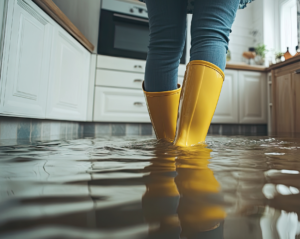A little bit of water can go a long way – as can the damage it causes. Are your tenants “escape of water ready”?
 Escape of water damage is one of the most common types of domestic property damage claims, with insurers paying out almost £2million for it every day*. These claims are one of the biggest concerns for insurers as well as causing considerable upheaval, inconvenience, and financial and emotional distress to your tenants when their personal property is damaged.
Escape of water damage is one of the most common types of domestic property damage claims, with insurers paying out almost £2million for it every day*. These claims are one of the biggest concerns for insurers as well as causing considerable upheaval, inconvenience, and financial and emotional distress to your tenants when their personal property is damaged.
Whilst some of these claims may be unavoidable due to storm or failed pipes, many can be prevented with care taken by occupiers. By actively looking to prevent water damage losses through a promoted programme of house-proud diligence (risk management vigilance), you can help safeguard against worry, inconvenient repairs, and escalating insurance premiums.
Where to start?
It is crucial that your tenants know the location of their stopcock and other isolation values so that the water supply can be quickly turned off in the event of a leak. Location labels should be used to highlight where they are. And don’t forget to regularly check them to ensure they operate properly when they are needed most.
Tenants should also be encouraged to check washing machine and drainage pipes as they can become loose overtime. One of these pipes becoming disconnected or incorrectly fitted could cause significant water damage to several properties. So, encourage tenants to check around the base of appliances to ensure there are no visible signs of water as small dips can quickly escalate into something more serious.
A number of organisations are now looking to provide very competitively priced washing machine installation services to their tenants to encourage them to make sure appliances are installed safely and correctly. Alternatively, you may wish to build a panel of approved plumbers and installers to fit appliances – helping to prevent those DIY failures.
One of the most preventable and often the costliest causes of water damage losses is failure of bath and shower seals, and old, badly fitted or miss-aligned waste pipes. This damage can go unnoticed for long periods of time and sometimes the leak only becomes apparent when the bathroom floor collapses into the flat below. Is it possible to have a system of preventative checks and proactive replacement of sealants around sinks, baths and showers, along with hairline cracks in shower trays? Regular visual checks will help you identify unseen leaks and act before it’s too late.
Slow draining sinks and baths can often be a warning sign that there is a blockage that needs to be cleared. Do you take the opportunity to remind tenants that discarded nappies, wet wipes, or cotton buds should not be flushed down the toilet?
Such reminders and increased awareness will help make your tenants “escape of water ready”!
If you would like guidance or suggestions on risk prevention steps suitable for inclusion in tenant handbooks/information packs or details of contents insurance schemes specifically designed for Local Authority and Housing Association tenants, please contact XXX

